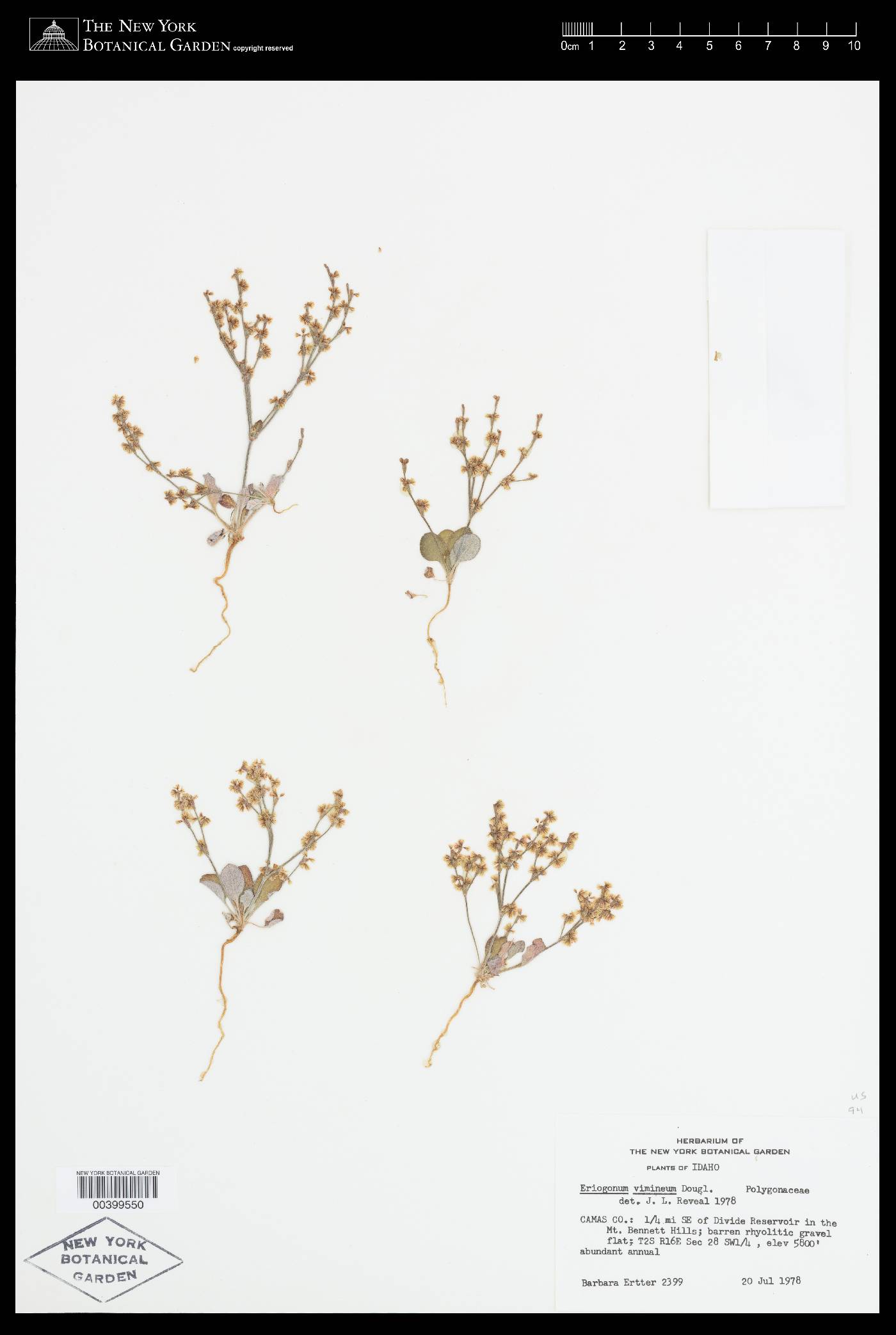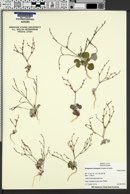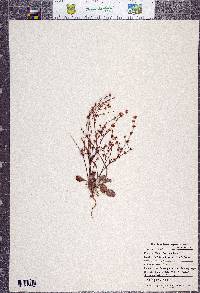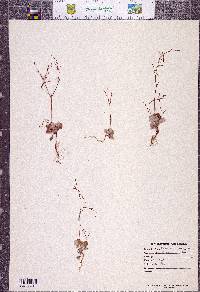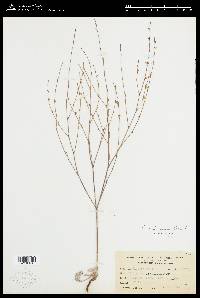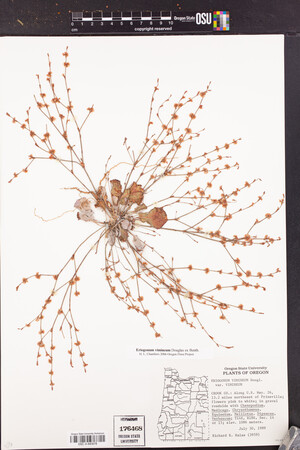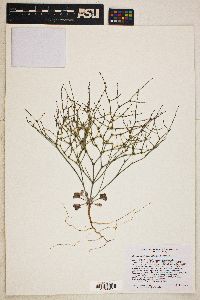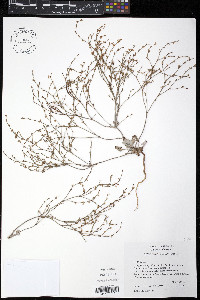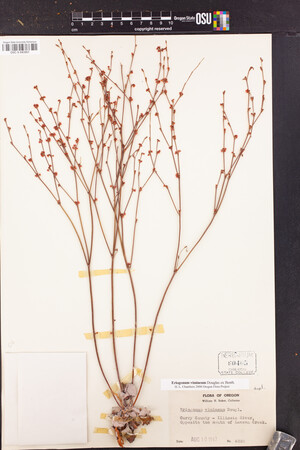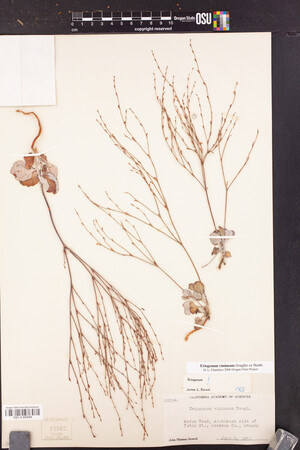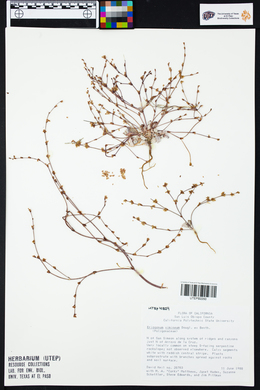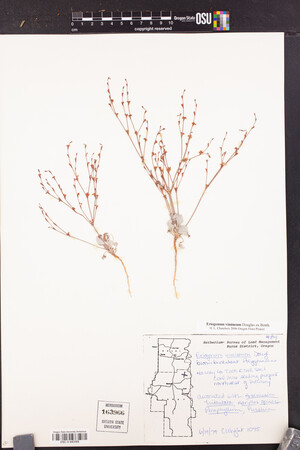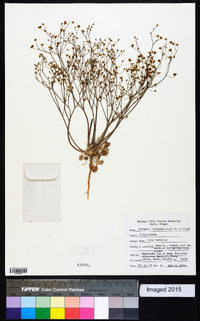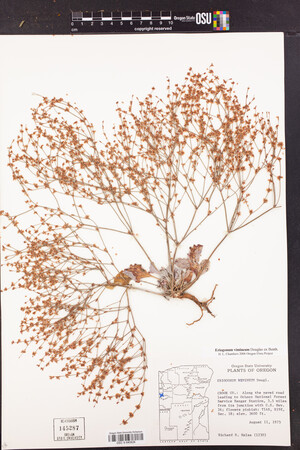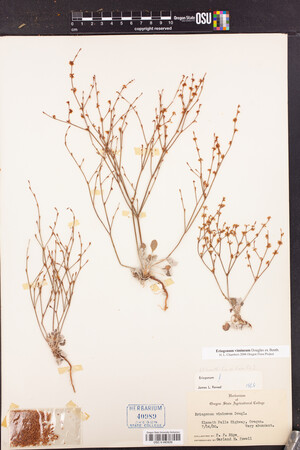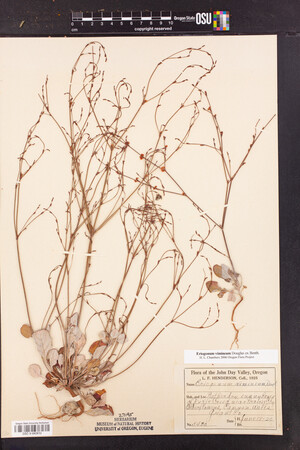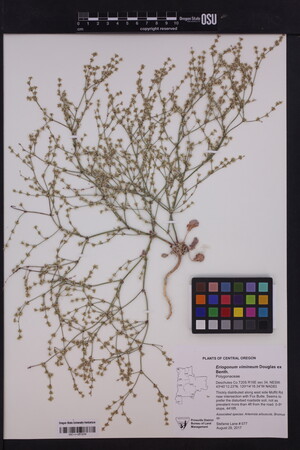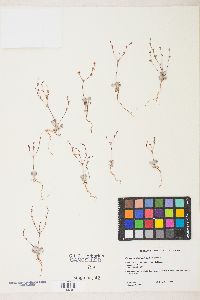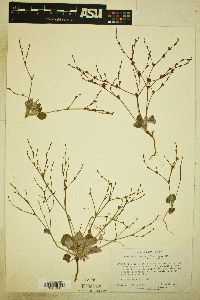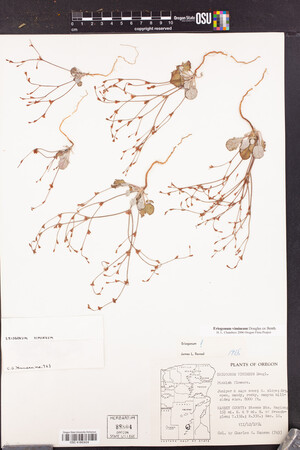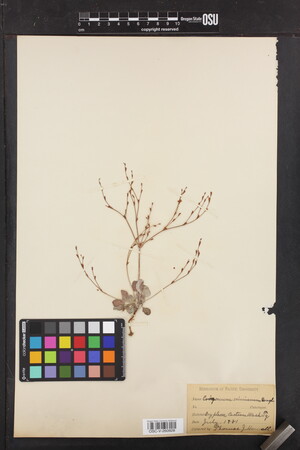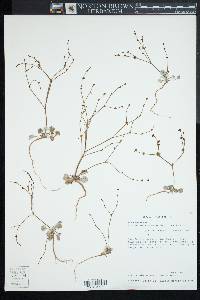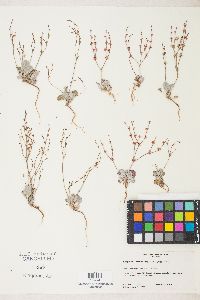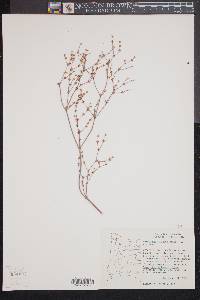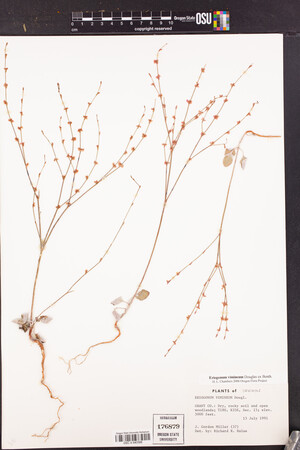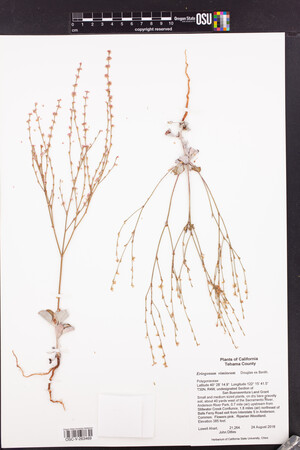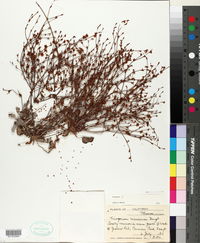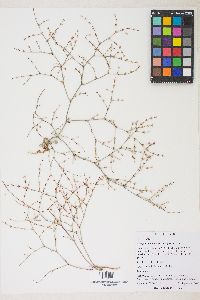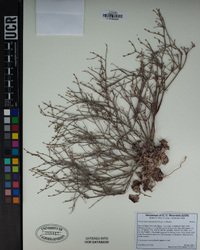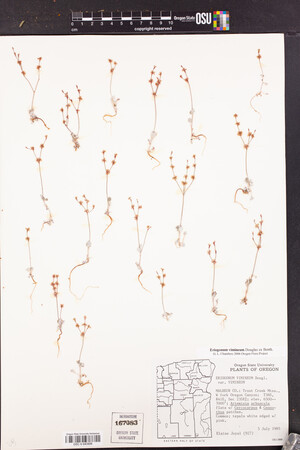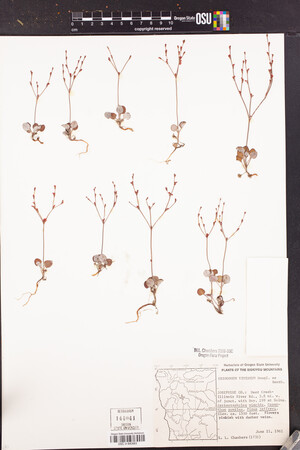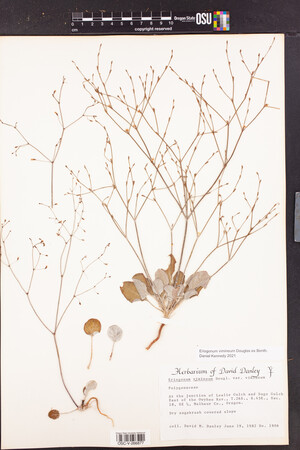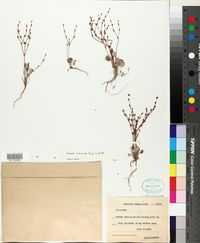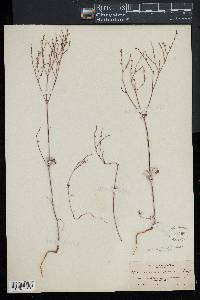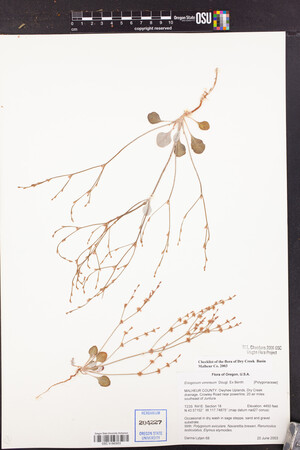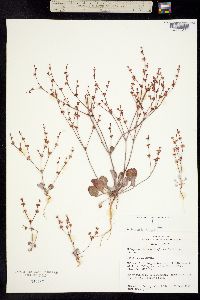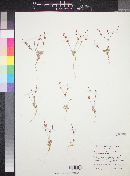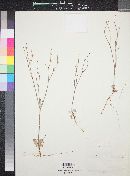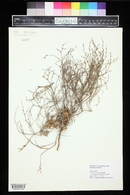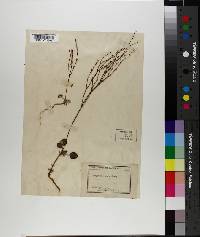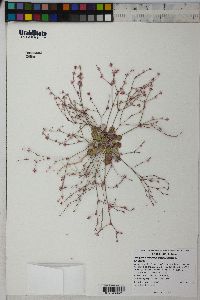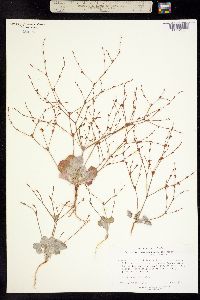Eriogonum vimineum
|
|
|
|
Family: Polygonaceae
Wicker-Stem Wild Buckwheat, more...wickerstem buckwheat, broom buckwheat
[Eriogonum shoshonense, moreEriogonum vimineum var. luteolum (Greene) S. Stokes, Eriogonum vimineum var. oregonense , Eriogonum vimineum var. rigescens , Eriogonum vimineum var. shoshonense (A. Nels.) S. Stokes] |
Herbs, erect to slightly spreading, 0.5-3(-5) dm, thinly tomentose to floccose or glabrous, grayish or reddish gray. Stems: aerial flowering stems erect, 0.5-1 dm, thinly tomentose to floccose, infrequently glabrous, straight or nearly so, infrequently inwardly curved distally. Leaves basal; petiole 1-4 cm, mostly floccose; blade round-ovate to rounded, 0.5-2(-2.5) × 0.5-2 cm, white-tomentose abaxially, less so to nearly glabrous and grayish or greenish adaxially. Inflorescences cymose, often distally uniparous due to suppression of secondary branches, open to somewhat diffuse, 5-25 × 5-25 cm; branches floccose or glabrous; bracts 1-3 × 1-2 mm. Peduncles absent. Involucres appressed to branches, narrowly cylindric, 2-3.5(-4) × 1-2 mm, glabrous or infrequently floccose; teeth 5, erect, 0.3-0.6 mm. Flowers 2-2.5 mm; perianth white to rose or pale yellow, glabrous; tepals slightly dimorphic, those of outer whorl broadly spatulate to obovate, those of inner whorl oblanceolate; stamens included, 1-1.5 mm; filaments pilose proximally or glabrous. Achenes brown, 3-gonous, 2-2.5 mm. 2n = 24. Flowering May-Sep. Sandy to gravelly flats and slopes, mixed grassland, saltbush, and sagebrush communities, oak, juniper, and montane conifer woodlands; 50-2400 m; Calif., Idaho, Nev., Oreg., Wash. Eriogonum vimineum is widespread and common to abundant or even locally weedy from southeastern Washington southward through central and eastern Oregon and western Idaho to northeastern California and northern Nevada. Except for occasional populations in northeastern California, where it can be confused with E. luteolum, this species is distinct, albeit variable, throughout its range.
FNA 2005, Jepson 2012, Kearney and Peebles 1969, McDougall 1973 Duration: Annual Nativity: Native Lifeform: Forb/Herb General: Herbaceous, scapose annuals to 30 cm tall, stems 1-several from the same base, erect to spreading and branching above, herbage more or less floccose or tomentose below but with the upper branches glabrous and green, sometimes glacous, lower portions grayish or reddish-gray. Leaves: All basal, with round or ovate blades to 1-2 cm long or broad, these glabrate above, white-tomentose beneath, petioles floccose, to 2 cm long or more. Flowers: Small, the flower-like calyxes red or pink to pale yellow, often with darker stripes, calyxes to 2 mm long, glabrous, the outer segments obovate with rounded apices, and narrower inner segments, involucres narrowly cylindric and ribbed, 2-3 mm long and 1-2 mm wide, with 5 short, blunt teeth to 0.6 mm long and glabrous surfaces, stamens included, to 1.5 mm long, filaments glabrous or pilose proximally, flowers borne sessile or lateral on short peduncles in cyme-like infloresences, subtended by scale-like or leaflike bracts. Fruits: Achenes, 3-sided (trigonus) red brown, to 2 mm long, glabrous. Ecology: Found on volcanic or granitic sandy or gravelly soils, on flats and slopes, in mixed grassland, saltbush, and sagebrush communities, oak, juniper, and montane conifer woodlands, from 150-8,000 ft (45-2438 m); flowering May-October. Distribution: Arizona, California, Idaho, Nevada, Oregon, Washington Ethnobotany: Specific uses for this species are unknown, but other species in the genus have uses; plant used for severe pain in hips and back, hemorrhage, menstruation medicine, to expedite childbirth, for internal pains, especially stomach pain, general indisposition, syphilis, infusion of plant taken to shrink the uterus and reduce dysmenorrhea, infusion of flowers used as an eyewash, to clean out the intestines, infusion of flowers and leaves used as a mouthwash for pyorrhea, leaves, growing near the root, used as a physic, salve of dry leaves or leaf ash mixed with grease used for swellings, decoction of roots taken for diarrhea, heart medicine, plants used in steambath for rheumatism, stiff and aching joints and muscles, and shoots and seeds used for food, stems used to brush off spines on fruits. Synonyms: Eriogonum shoshonense, E. vimineum var. shoshonense Editor: LCrumbacher2012 Etymology: Eriogonum comes from the Greek erion, "wool," and gonu, "joint or knee," in reference to the hairy or woolly joints of some of the species of the genus, and vimineum means with long slender shoots. |

